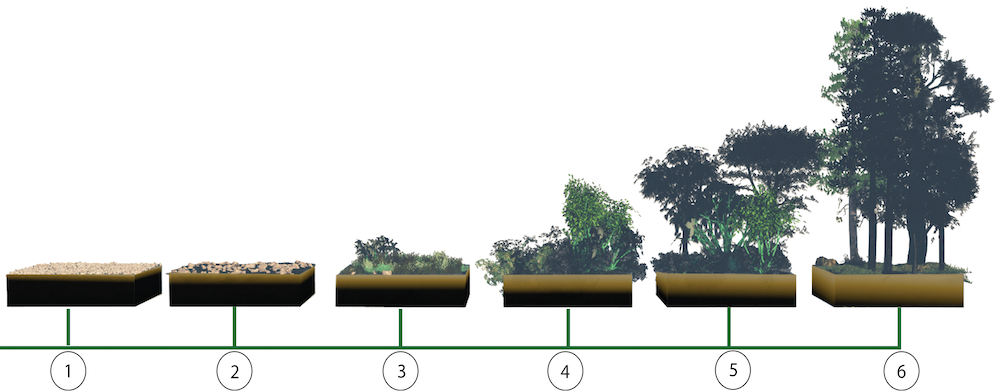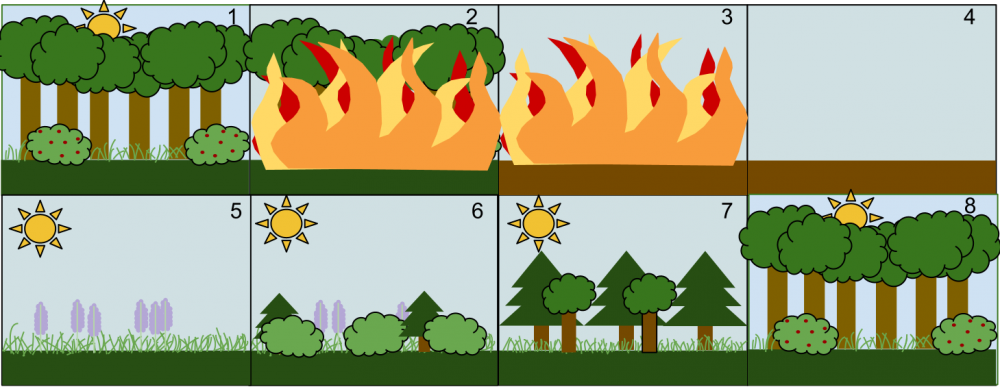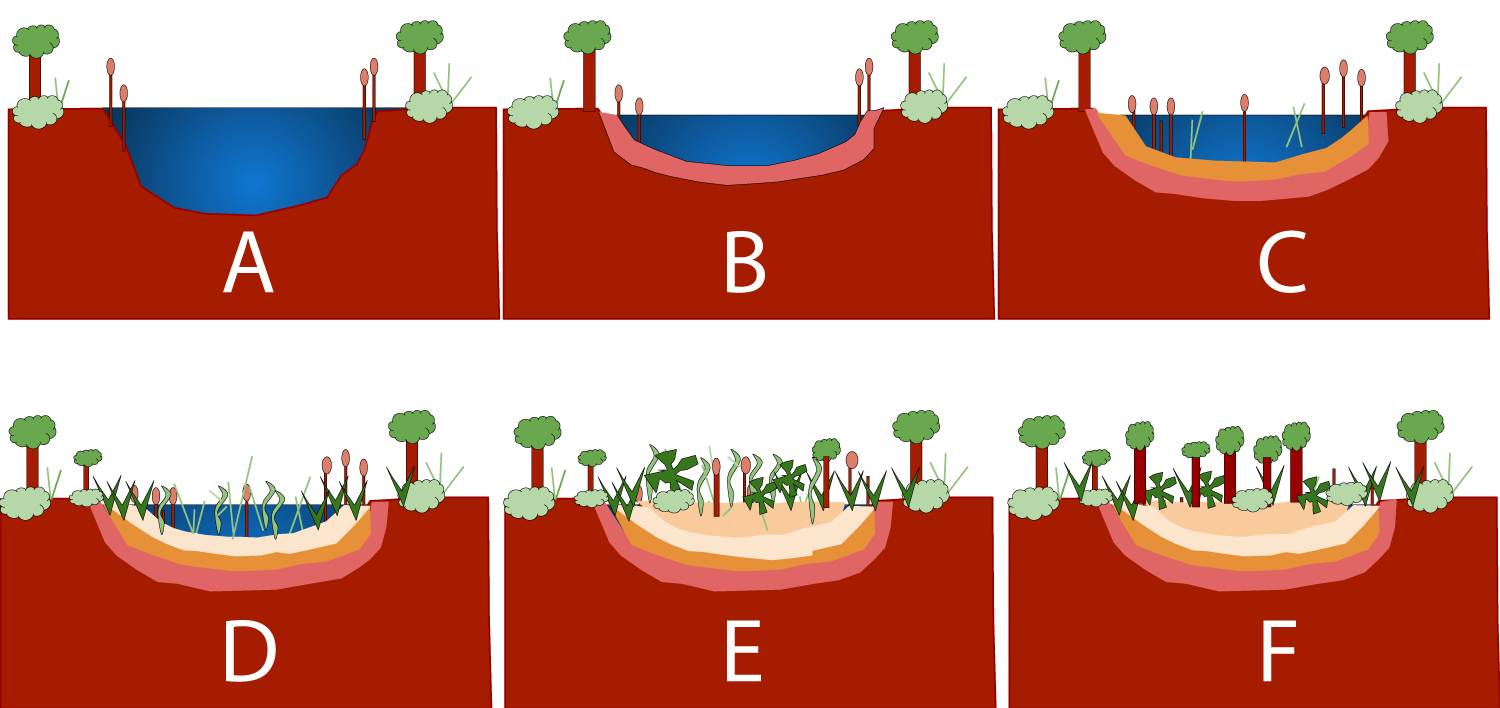1. Watch this Video
2. Study this Summary
What is Ecological Succession?
Ecological succession is the process by which biological communities undergo predictable changes following a disturbance such as a fire, flood, landslide, or volcanic eruption. Each stage of succession modifies environmental conditions, allowing different plant and animal species to establish, eventually leading to a stable climax community.
Primary Succession

- Occurs in areas where there was no previous soil, such as after a volcanic eruption, glacier retreat, or rockslide.
- Begins with pioneer species like lichens and algae that break down rock and contribute to soil formation.
- Over time, soil accumulation allows for the establishment of mosses, herbs, grasses, shrubs, and eventually trees.
Stages of Primary Forest Succession
Note: The numbered stages below refer to the diagram above
- Bare substrate – The process begins with exposed rock or soil.
- Pioneer species – Organisms like lichens and algae colonize the area, starting soil formation.
- Early colonizers – Sun-tolerant mosses and herbs contribute organic material, enriching the soil.
- Sun tolerant grasses, ferns, and small shrubs – As soil depth increases, these plants take root.
- Small trees and shade tolerant shrubs– Larger plants provide shade and new habitats.
- Climax community – A stable, mature ecosystem develops, persisting until another disturbance resets the cycle.
Secondary Forest Succession

- Occurs in areas where soil remains intact after a disturbance, such as after a wildfire, flood, or deforestation.
- Since soil is already present, plant communities re-establish more quickly than in primary succession.
Trends in Ecological Succession
- Abiotic conditions (nonliving factors) are replaced by biotic conditions as plant and animal life get established.
- Soil mass increases, providing nutrients for future growth.
- Biodiversity increases, leading to more species interactions.
- The community becomes more stable and resilient over time.
Succession in Ponds; other succession processes

- During pond succession, sediment accumulation gradually transforms a pond into a wetland or forested area.
- When whales die at sea, their bodies fall to the ocean floor. Decomposition of the body occurs in a series of stages that support a sequence of distinct ecosystems. To learn more, read this article about whale fall on Wikipedia
3. Master these Flashcards
[qdeck qrecord_id=”sciencemusicvideosMeister1961-Ecological Succession Flashcards, APBioVideoPath”]
[h]Ecological Succession
[i]
[q json=”true” yy=”4″ unit=”8.Ecology” dataset_id=”AP_Bio_Flashcards_2022|1094d15458d10″ question_number=”419″ topic=”8.5-6.Community_Ecology_and_Biodiversity”] What is ecological succession?
[a] Ecological succession is how the mix of species within a community changes following a disturbance (such as a fire, flood, landslide, or volcanic eruption. Each mix of species creates conditions that subsequently allow different plant communities to thrive. Succession culminates in a “climax” community that endures in relative equilibrium until a disturbance restarts the succession process.
[q json=”true” yy=”4″ unit=”8.Ecology” dataset_id=”AP_Bio_Flashcards_2022|108ba66587110″ question_number=”420″ topic=”8.5-6.Community_Ecology_and_Biodiversity”] Describe how primary ecological succession typically unfolds. Focus on plant communities.
[a] The process starts with colonization by pioneer species — lichens and algae that can live on bare rock. They begin a slow process of biomass accumulation and soil development. Next come sun-tolerant mosses and herbs, who create enough soil for sun-tolerant grasses and ferns. Then come small shrubs, then trees, which create a shady understory, which creates a niche for shade-tolerant shrubs. Ultimately, a self-perpetuating climax community develops.
[q json=”true” dataset_id=”AP_Bio_Flashcards_2022|112095dca605″ question_number=”421″ unit=”8.Ecology” topic=”8.5-6.Community_Ecology_and_Biodiversity”] How is primary succession different from secondary succession?
[a] Primary succession starts from bare rock and requires a slow process of soil creation. In secondary succession, the soil is intact, and the succession process can unfold much more quickly.
[q json=”true” yy=”4″ unit=”8.Ecology” dataset_id=”AP_Bio_Flashcards_2022|107cf3da77d10″ question_number=”422″ topic=”8.5-6.Community_Ecology_and_Biodiversity”] What are the overall trends associated with ecological succession?
[a] Here are the overall trends associated with ecological succession:
- Abiotic conditions are replaced by biotic conditions
- Soil mass increases
- Overall biodiversity increases
- The number of interspecific interactions increases
- The community becomes more stable and more resilient to change.
[x]
[restart]
[/qdeck]
4. Tackle this Quiz
[qwiz style=”width: 650px !important; min-height: 400px !important;” qrecord_id=”sciencemusicvideosMeister1961-Ecological Succession Quiz, APBioVideoPath”]
[h]Ecological Succession Quiz
[i]
[q labels = “top”]
- Throughout ecological succession, the assembly of species shifts from __ selected to ___ selected.
- _________ environmental conditions are replaced by __________ environmental conditions
- Soil mass ___________.
- Biomass ____________.
- The number of interspecific interactions ___________.
- The lifespan of organisms in the community shifts from a __________ lifespan to a __________ one.
- The community becomes _________ stable and __________ resistant to change.
- The physical structure of the community becomes more ____________.
[l]abiotic
[fx] No, that’s not correct. Please try again.
[f*] Good!
[l]biotic
[fx] No, that’s not correct. Please try again.
[f*] Excellent!
[l]complex
[fx] No, that’s not correct. Please try again.
[f*] Excellent!
[l]increases
[fx] No. Please try again.
[f*] Excellent!
[l]K
[fx] No, that’s not correct. Please try again.
[f*] Great!
[l]longer
[fx] No, that’s not correct. Please try again.
[f*] Correct!
[l]more
[fx] No, that’s not correct. Please try again.
[f*] Correct!
[l]r
[fx] No. Please try again.
[f*] Great!
[l]shorter
[fx] No. Please try again.
[f*] Great!
[q labels=”top”]The basic idea of ecological succession is that over time, the composition of a community will __________. As a community ages, each stage sets up conditions for the _________ one. This continues until a community develops into a self-_______________ __________ community.
[l]climax
[f*] Good!
[fx] No. Please try again.
[l]change
[f*] Excellent!
[fx] No. Please try again.
[l] perpetuating
[f*] Good!
[fx] No. Please try again.
[l]next
[f*] Good!
[fx] No. Please try again.
[q] The process by which the composition of a community changes over time is called ecological [hangman].
[c]IHN1Y2Nlc3Npb24=[Qq]
[f]IEdvb2Qh[Qq]
[q] In the course of ecological succession, the self-perpetuating community that arises at the end of the process is called the [hangman] community.
[c]IGNsaW1heA==[Qq]
[f]IEV4Y2VsbGVudCE=[Qq]
[q] The type of succession process that begins with rock or sand — or, in other words, without soil— is called [hangman] succession.
[c]IHByaW1hcnk=[Qq]
[f]IENvcnJlY3Qh[Qq]
[q] The diagram below represents [hangman] succession
[c]IHNlY29uZGFyeQ==[Qq]
[f]IEdvb2Qh[Qq]
[q] You can tell that the diagram below represents [hangman] succession because of the lack of [hangman] at the start of the process.
[c]IHByaW1hcnk=[Qq]
[f]IEdyZWF0IQ==[Qq]
[c]IHNvaWw=[Qq]
[f]IENvcnJlY3Qh[Qq]
[q] In the diagram below, you could expect to find pioneer species such as lichens and mosses in stage
[textentry single_char=”true”]
[c]ID I=[Qq]
[f]IEV4Y2VsbGVudC4gVGhlIGVhcmxpZXN0IGNvbG9uaXplcnMgKG1vc3NlcyBhbmQgbGljaGVucykgd291bGQgYmUgcHJlc2VudCBpbiBzdGFnZSAyLg==[Qq]
[c]IEVudGVyIHdvcmQ=[Qq]
[f]IE5vLg==[Qq]
[c]ICo=[Qq]
[f]IE5vLiBIZXJlJiM4MjE3O3MgYSBoaW50LiBTdGFnZSAxIGlzIGJhcmUgcm9jay4gV2hpY2ggc3RhZ2Ugc2hvd3MgZWFybHkgY29sb25pemVycyBsaWtlIG1vc3NlcyBhbmQgbGljaGVucyBjb21pbmcgaW4gdG8gY29sb25pemUgdGhpcyByb2NreSBhcmVhPw==[Qq]
[q] In the diagram below, stage 2 shows the arrival of [hangman] species such as mosses and lichens. Stage 6 shows a [hangman] community.
[c]IHBpb25lZXI=[Qq]
[f]IEdyZWF0IQ==[Qq]
[c]IGNsaW1heA==[Qq]
[f]IEdyZWF0IQ==[Qq]
[q] In the diagram below, which number shows the climax community? Note that two answers are possible, and you can enter either one.
[textentry single_char=”true”]
[c]ID E=[Qq]
[f]IE5pY2Ugam9iISBCb3RoIDEgYW5kIDggc2hvdyB0aGUgY2xpbWF4IGNvbW11bml0eQ==[Qq]
[c]ID g=[Qq]
[f]IE5pY2Ugam9iISBCb3RoIDEgYW5kIDggc2hvdyB0aGUgY2xpbWF4IGNvbW11bml0eQ==[Qq]
[c]IEVudGVyIHdvcmQ=[Qq]
[f]IFNvcnJ5LCB0aGF0JiM4MjE3O3Mgbm90IGNvcnJlY3Qu[Qq]
[c]ICo=[Qq]
[f]IE5vLiBIZXJlJiM4MjE3O3MgYSBoaW50LiBUaGUgY2xpbWF4IGNvbW11bml0eSBpcyB0aGUgc2VsZi1wZXJwZXR1YXRpbmcgY29tbXVuaXR5IHRoYXQgd2lsbCByZXBsYWNlIGl0c2VsZiBhbmQgcGVyc2lzdCAodW50aWwgdGhlIG5leHQgZmlyZSku[Qq]
[q]The diagram below shows the stages of pond succession, arranged randomly. Number them from earliest (1) to latest (6)
[f*] Excellent!
[fx] Sorry, that’s not correct.
[l]2
[fx] No. Please try again.
[f*] Correct!
[l]3
[fx] No. Please try again.
[f*] Excellent!
[l]4
[fx] No. Please try again.
[f*] Excellent!
[l]5
[fx] No, that’s not correct. Please try again.
[f*] Great!
[l]6
[fx] No. Please try again.
[f*] Great!
[q json=”true” xyz=”2″ multiple_choice=”true” dataset_id=”2019 AP Bio Dataset|2109bf52d5d85a” question_number=”452″ unit=”8.Ecology” topic=”8.5.Community_Ecology”] The 2018 lava flows on the Big Island of Hawaii completely destroyed the forest community where they occurred, replacing the forest with volcanic rock.
Following this event, what type of ecological succession will occur, and what types of organisms will be the first to establish themselves?
[c]IFByaW1hcnkgc3VjY2Vzc2lvbiB3aWxsIG9jY3VyLiBHcmFzc2VzIGFuZCBwaW5lIHRyZWVzIHdpbGwgYmUgdGhlIGZpcnN0IHRvIGVzdGFibGlzaCB0aGVtc2VsdmVzLg==[Qq]
[f]IE5vLiBZb3UmIzgyMTc7cmUgcmlnaHQgYWJvdXQgdGhlIHR5cGUgb2Ygc3VjY2Vzc2lvbiwgYnV0IGNob29zZSBhIHNpbXBsZXIsIHNtYWxsZXIgb3JnYW5pc20gYXMgdGhlIGZpcnN0IHBpb25lZXIu[Qq]
[c]IFByaW1hcnkgc3VjY2Vzc2lvbiB3aWxsIG9jY3VyLiBMaWNoZW5zIGFuZCBtb3 NzZXMgd2lsbCBiZSB0aGUgZmlyc3QgdG8gZXN0YWJsaXNoIHRoZW1zZWx2ZXMu[Qq]
[f]IENvcnJlY3QuIFdoZW4gYSBjb21tdW5pdHkgaGFzIHRvIHJlYnVpbGQgaXRzIHNvaWwsIHRoZSBzdWNjZXNzaW9uIHRoYXQgZm9sbG93cyBpcyBjb25zaWRlcmVkIHRvIGJlIHByaW1hcnksIGFuZCB0aGUgZmlyc3Qgb3JnYW5pc21zIHRvIGNvbG9uaXplIHRoZSByb2NrcyB3aWxsIGJlIGxpY2hlbnMgYW5kIG1vc3Nlcy4=[Qq]
[c]IFByaW1hcnkgc3VjY2Vzc2lvbiB3aWxsIG9jY3VyLiBBIHJhbmdlIG9mIHBsYW50IHNwZWNpZXMgKGdyYXNzZXMsIHNocnVicywgYW5kIHRyZWVzKSB3aWxsIHJhcGlkbHkgZXN0YWJsaXNoIHRoZW1zZWx2ZXMu[Qq]
[f]IE5vLiBZb3UmIzgyMTc7cmUgcmlnaHQgYWJvdXQgdGhlIHR5cGUgb2Ygc3VjY2Vzc2lvbiwgYnV0IGNob29zZSBhIHNpbXBsZXIsIHNtYWxsZXIgb3JnYW5pc20gYXMgdGhlIGZpcnN0IHBpb25lZXIu[Qq]
[c]IFNlY29uZGFyeSBzdWNjZXNzaW9uIG9jY3Vycy4gR3Jhc3NlcyBlc3RhYmxpc2ggdGhlbXNlbHZlcyBmaXJzdC4=[Qq]
[f]IE5vLiBTZWNvbmRhcnkgc3VjY2Vzc2lvbiB1c3VhbGx5IGZvbGxvd3MgYSBmaXJlIG9yIGEgZmxvb2QuIFRoZSBjb21tdW5pdHkmIzgyMTc7cyBzb2lsIGlzIHN0aWxsIGludGFjdC4gSW4gdGhlIGNhc2Ugb2YgdGhlc2UgSGF3YWlpYW4gbGF2YSBmbG93cywgbmF0dXJlIHJlZHVjZWQgdGhlIGNvbW11bml0eSB0byBiYXJlIHJvY2suIFJlbWVtYmVyIHRoYXQgd2hlbiB5b3Ugc2VlIHRoaXMgcXVlc3Rpb24gYWdhaW4u[Qq]
[c]IFNlY29uZGFyeSBzdWNjZXNzaW9uIG9jY3Vycy4gUGluZXMgYXJlIHRoZSBmaXJzdCB0byBlc3RhYmxpc2ggdGhlbXNlbHZlcy4=[Qq]
[f]IE5vLiBTZWNvbmRhcnkgc3VjY2Vzc2lvbiB1c3VhbGx5IGZvbGxvd3MgYSBmaXJlIG9yIGEgZmxvb2QuIFRoZSBjb21tdW5pdHkmIzgyMTc7cyBzb2lsIGlzIHN0aWxsIGludGFjdC4gV2l0aCB0aGVzZSBsYXZhIGZsb3dzLCBuYXR1cmUgcmVkdWNlZCB0aGUgY29tbXVuaXR5IHRvIGJhcmUgcm9jay4gUmVtZW1iZXIgdGhhdCB3aGVuIHlvdSBzZWUgdGhpcyBxdWVzdGlvbiBhZ2Fpbi4=
Cg==W3Jlc3RhcnRd[Qq]
[/qwiz]
What’s next?
Please proceed to this next tutorial: Biodiversity and the Simpson Diversity Index
